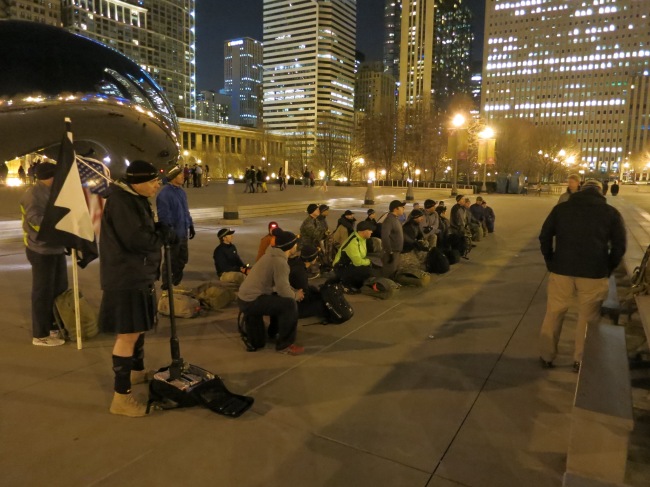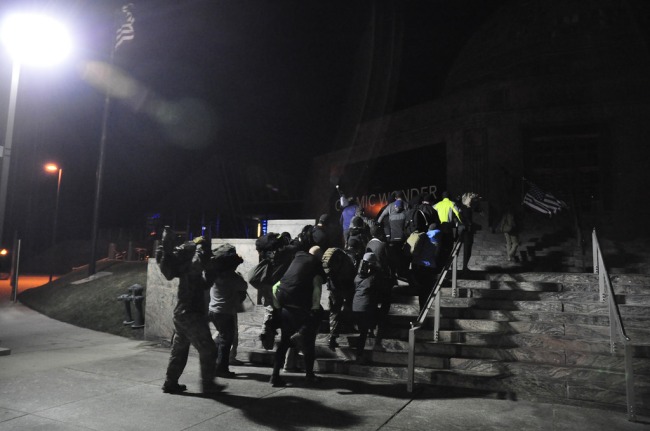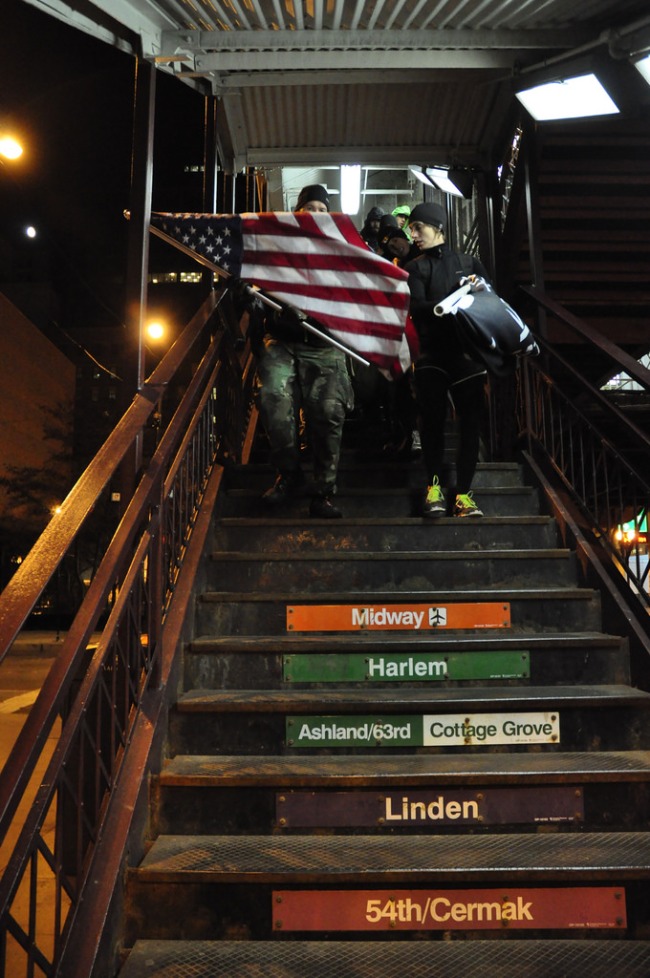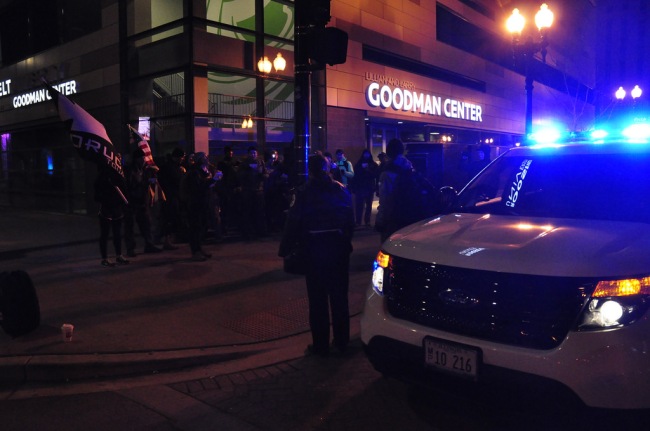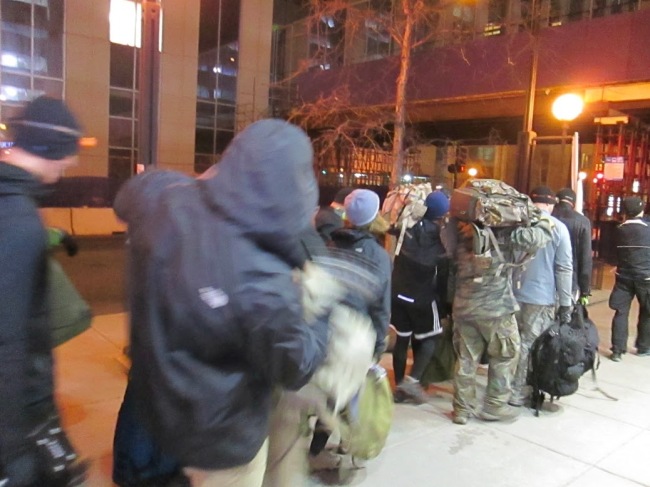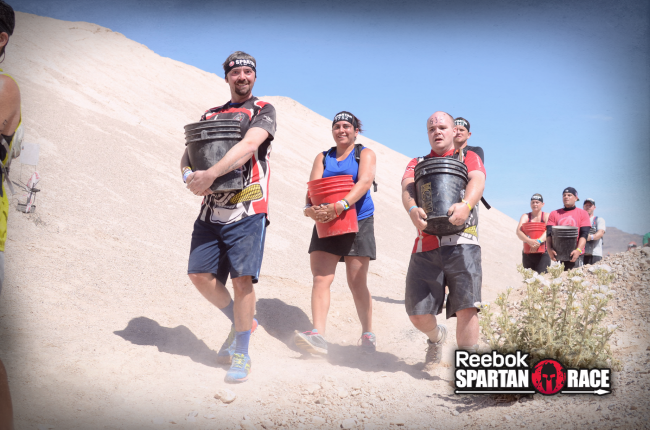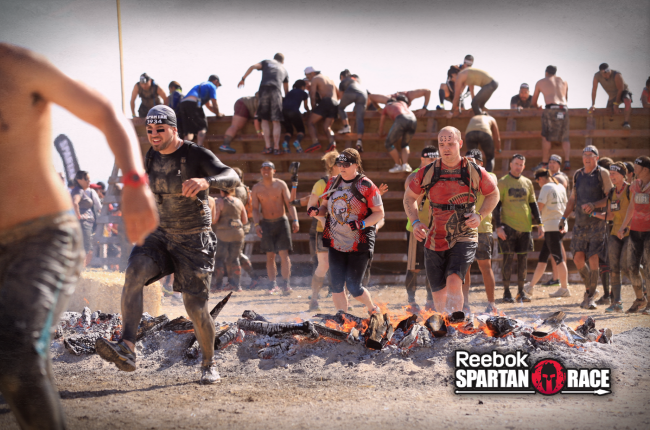I was a little hesitant going into this event, as my last full GORUCK Challenge was completed successfully, but I was a drag on the team rather than being an asset. I knew I was stronger going into this one, but I was not sure if I was strong enough.
I found the sculpture that was the landmark for our start point, found my teammates, and chatted waiting for the Cadre to arrive and determine where we went from there.
Our Cadre (going by the highly improbable name of Surfhog) arrived, gave us the usual instructions, and appointed a team leader to make certain we all had our required gear squared away. He told us his background, announced, “It begins!” and lead us off at a pace that many of us struggled to keep up with. Along the way he punished mistakes that we made with designating casualties, meaning the person he pointed to had to be carried by the rest of the team. We reached a park and started the welcome party.
The goal was to get everyone working as a team, all PT movements to be done in unison. The longer it takes you to make it happen, the more PT you end up doing. It took us awhile to get it together, due in part to me. On several of the exercises I couldn’t make things work, having to drop my feet in flutter kicks or drop a knee in pushups. On the up side, I had been wondering for some time if I am strong enough to do a decent buddy carry, and I got my answer.
After much PT, more than a few doubts about coming, and seeing a few of our number drop, we were assembled into a circle and briefed on our mission for the night. A B52 has gone down, carrying three nuclear weapons. We must HALO in, coordinate with local sources, and recover the weapons. If possible, we are to recover the aircraft’s black boxes as well.
The HALO in: we all must lay on our bellies with head, legs and arms elevated off the ground, for two minutes. After costing us in the welcome party, there was no way I was going to be the weak link here. Cadre gave us 3-2-1 GO! and I lifted up and tried to calm my mind and just count out breaths. We hit 60 seconds with no trouble. Around 90 seconds the shouts of encouragement really picked up, and we all made it. Next step was to get to a treeline, stop to observe our surroundings, and then to move out using the treeline as cover.
We reached our objective with only a few complications, and recovered the first nuclear device (played by a duffel bag full of sand weighing somewhere from 300-500 pounds.)
New team lead, new objective, and we carried off the bomb to go locate the other two. 6 people carried the bomb on a litter, and we switched out carriers as they got tired. This is where me thinking too much became a problem. When I know I am one of the weaker of a group, I am always unsure if I should step up for heavier duty, or look after lighter tasks and leave the heavier tasks to those who can do a better job of it. This got worse when we screwed something up (I think we broke formation, but I’m not certain) and Cadre punished us by making us hand-carry our rucks as though the straps had broken.
OK, the previous time when Cadre John took our shoes was tough but amusing. Taking our pack straps is not freaking funny. It took so much of my effort to just keep up and not drop my ruck that I felt absolutely useless to the team.
Memories of exact sequence of events begins to get fuzzy about here, but one of our objectives was to get the team to the doors of a planetarium within a certain time. We missed the time hack, which would have gotten us our ruck straps back.
The challenge that got our straps back came after several attempts to get everyone and all our gear up the stairs in under 20 seconds, and finally changing our methods to get there on time.
We set out on our next movement and missed our time hack. In the resulting PT session, I and a few others were called out for not doing flutter kicks properly. I just couldn’t get my body to sort itself out and keep my feet elevated as required. I gave all that I had, and just barely achieved the minimum that would let us continue.
Next missed time hack, Cadre asked the team leader what exercise we should be penalized with. Without hesitation, the TL chose burpees. The rest of us looked at him like, “What the hell. Really. What the hell.” TL explained that if we could do this well, and as a team, it would show Cadre that we were not intentionally slacking off. We were able to do them together, on cadence, and were able to move on wearing our rucks rather than carrying them. Epic win.
We picked up the second nuke sometime in the wee morning hours, and had to carry both of them up and down every set of El Train stairs we passed. I can’t remember, but I think that we had the black boxes (50 lb. sandbags) at this point as well.
The police stopped in to ask what we were doing. (It should be noted that we were also expected to memorize two songs before we arrived.) Cadre explained what GRC is, and somehow we ended up singing “Girls Just Want to Have Fun” to the police.
I couldn’t figure out how to carry anything else while we were hand-carrying our rucks, until the announcement to take off the rucks came while I was helping carry one of the bombs. That left no choice but to do what was needed, so I learned that I could.
We picked up the third nuke right around sunrise. Sun coming up over the lake was beautiful and somehow did make things seem better. We rested for a few minutes, and Cadre announced that we were going to do do flutter kicks in honor of the sunrise. After my failure earlier in the night, I was determined to keep with cadence and make the form absolutely perfect. And, while I am not sure if due to increased determination or being a bit more rested, I was able to knock them out.
All three bombs up, and off we go.
By this time, I was no longer fussing over who was the right person to do the task at hand, and neither was anyone else. Someone carrying the bomb called out for a replacement, we all stepped up. In some cases we could only carry for a few minutes before needing a replacement ourselves, but it gave everyone else time to sort themselves out before going back in. We only had five alternates to pick from with 18 people carrying the bombs, so with that few to work with, any little bit you can help counts. In short, we had stopped being individuals and become a team.
We reached our objective (on time) and disposed of two of the bombs. The last one had to be carried back to the beach. When we got it there, we were told to take off anything that we wanted dry, as we were about to get wet.
We linked arms, went out to belly depth, turned to face the shore, and awaited Cadre’s signal. When he gave us a thumb-down, we all went under. I came back up and say he was signalling to do it again. get the team together, ready, okay, back under. When I came back up Cadre was calling us back to the beach.
Cadre announced our Exfil, and we all moved in formation back to our start point. Much of the time we latched on to the ruck in front of us to make sure we stayed together. We arrived back at the park, received our patches, and the shadows shared beer with us before we all left.
I learned two big things from this event:
1. Practicing the exercises that you are worst at is not enough. You must be able to do them even when you are tired.
2. Don’t worry about if you are the correct person to do what needs done, just step up and do it. If you find you have bitten off more than you can handle, switch out as needed, but fussing about this beforehand leads to no one stepping up when it needs done.


